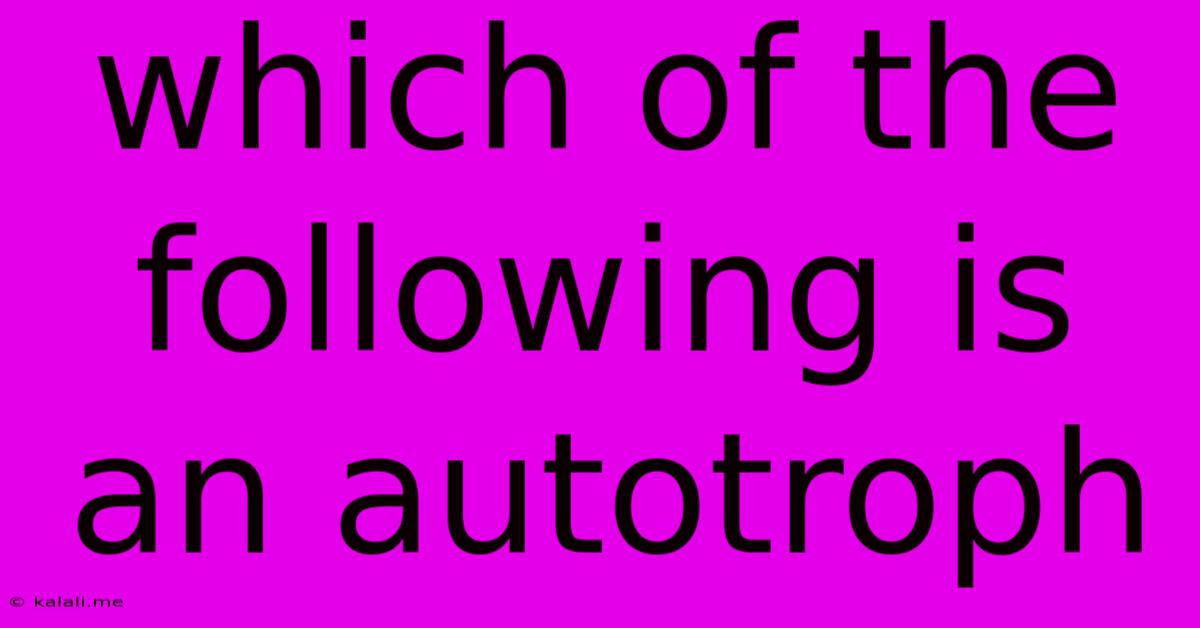Which Of The Following Is An Autotroph
Kalali
Jun 12, 2025 · 3 min read

Table of Contents
Which of the Following is an Autotroph? Understanding Autotrophs and Heterotrophs
This article will explore the concept of autotrophs, differentiating them from heterotrophs and providing clear examples. Understanding autotrophs is crucial for grasping fundamental ecological concepts and the flow of energy within ecosystems. We'll delve into the characteristics of autotrophs and explore how they contribute to the food chain.
What is an Autotroph?
An autotroph, often called a "producer," is an organism that can produce its own food using inorganic substances like carbon dioxide and water. This process, primarily photosynthesis, utilizes light energy to convert these simple compounds into complex organic molecules, such as glucose, which serve as their energy source. Essentially, autotrophs are self-feeders, forming the base of most food chains. They are vital to the planet's ecosystems, providing the primary source of energy for all other life forms.
The Process of Photosynthesis: How Autotrophs Create Food
Photosynthesis is the key process by which most autotrophs obtain their energy. This complex biochemical reaction involves several steps:
- Light Absorption: Chlorophyll, a green pigment found in plants and algae, absorbs light energy from the sun.
- Water Uptake: Water is absorbed from the soil through the roots (in plants) or from the surrounding environment.
- Carbon Dioxide Intake: Carbon dioxide is taken in from the atmosphere through stomata (in plants) or directly from the water (in aquatic autotrophs).
- Energy Conversion: The absorbed light energy is used to convert water and carbon dioxide into glucose (a sugar) and oxygen.
- Glucose Utilization: The produced glucose serves as the autotroph's source of energy and building blocks for growth and other metabolic processes.
- Oxygen Release: Oxygen, a byproduct of photosynthesis, is released into the atmosphere.
Examples of Autotrophs:
Several types of organisms are classified as autotrophs. The most common examples include:
- Plants: These are the most familiar autotrophs, utilizing sunlight, water, and carbon dioxide to create their own food through photosynthesis. Examples range from towering trees to tiny flowering plants.
- Algae: These diverse aquatic organisms, ranging from single-celled to multicellular forms, also photosynthesize, forming the base of many aquatic food webs.
- Cyanobacteria (Blue-green algae): These prokaryotic organisms are among the earliest forms of life on Earth and played a crucial role in oxygenating the atmosphere. They also perform photosynthesis.
- Chemoautotrophs: Unlike photosynthetic autotrophs, chemoautotrophs utilize chemical energy from inorganic compounds, such as hydrogen sulfide or methane, to produce their own food. These organisms are often found in extreme environments like deep-sea hydrothermal vents.
Distinguishing Autotrophs from Heterotrophs
In contrast to autotrophs, heterotrophs cannot produce their own food and must obtain energy by consuming other organisms. Heterotrophs are the "consumers" in the food chain, relying on autotrophs or other heterotrophs for their sustenance. Examples of heterotrophs include animals, fungi, and many bacteria.
Conclusion: The Importance of Autotrophs
Autotrophs are fundamentally important to life on Earth. They are the primary producers, forming the base of virtually all food chains and providing the energy that sustains all other life forms. Their ability to convert inorganic compounds into organic matter through photosynthesis or chemosynthesis is vital for the planet's ecosystems and the overall balance of nature. Understanding their role is key to appreciating the intricate interconnectedness of the natural world.
Latest Posts
Latest Posts
-
Transitive And Intransitive Verbs Exercises With Answers
Jun 13, 2025
-
What Number Is A Multiple Of 6
Jun 13, 2025
-
How Long Does It Take Earth To Complete One Rotation
Jun 13, 2025
-
Which Of The Following Came First
Jun 13, 2025
-
What Is The Lightest Element On The Periodic Table
Jun 13, 2025
Related Post
Thank you for visiting our website which covers about Which Of The Following Is An Autotroph . We hope the information provided has been useful to you. Feel free to contact us if you have any questions or need further assistance. See you next time and don't miss to bookmark.